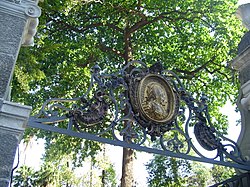Passeio Público (Rio de Janeiro)
| Passeio Público | |
|---|---|

Entrance gate of the Passeio Público with effigies of the Kings of Portugal
|
|
| Type | Public park |
| Location | Rio de Janeiro, Brazil |
| Coordinates | Coordinates: 22°54′49.67″S 43°10′33.55″W / 22.9137972°S 43.1759861°W |
| Created | 1779 |
| Designated | 99/6 |
| Reference no. | 1938 |
The Passeio Público is a public park in the historic centre of Rio de Janeiro, Brazil. Built after 1779, it is the oldest public park of Brazil and one of the oldest in the Americas.
In 1763, the seat of government of colonial Brazil was transferred from Salvador de Bahia to the city of Rio de Janeiro. Among other improvements in the new colonial capital, Viceroy Luís de Vasconcelos had the idea of creating a public park in the capital of the colony, inspired by the Passeio Público (Public Park) created in the 1760s in Lisbon, as well as the Baroque-Rococo garden of the Royal Palace of Queluz. Thus, in 1779 the Viceroy commissioned the building of the park to Valentim da Fonseca e Silva (Master Valentim), the main sculptor and urban planner of Rio at the time and an active collaborator of the Viceroy. The works would be completed in 1783.
The park was built on land reclaimed from a lagoon located beside the Guanabara Bay. This lagoon — known as Lagoa do Boqueirão — was polluted and bred diseases, and its elimination was considered a major improvement in the urban conditions of Rio.
Master Valentim planned a park in the French formal garden style, in the shape of an irregular hexagon, using straight pathways arranged in a geometrical and symmetrical form. By the sea, the park had a terrace from which wonderful views of Guanabara Bay could be enjoyed. This terrace also had two pavilions decorated with paintings. Master Valentim decorated the park with various species of trees, as well as fountains and statues.
The park was originally encircled by a stone wall and was mostly used by Rio's high colonial society, but after 1793 it was opened to the general public.
...
Wikipedia

